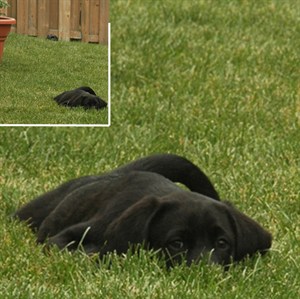Sledging rocks for veggies' sake
Last week we helped dig to make a vegetable garden in a back
yard in Guelph, Ontario. A tough situation with several possible solutions, all followed by
our answer, and the resulting
fun. With an August report on how it came
out.
The situation
The gardener had stripped off the sod, dug in to check the
drainage and become discouraged after finding a rocky layer about
ten inches down.

Plants don't mind rocks but when we investigated we found
crushed rock compressed into a tight cap (below, right: between the
two blue lines) over better soil below.
Below: Compare the condition of the top soil (left side of
the frame) and what's below the rock (right side). The topsoil is
floury -- lacking pores to help it absorb water, drain, and allow
air to reach roots. It's gray, meaning it has little organic matter
in it to entice soil animals and microorganisms that might push its
minerals into a better condition.
The soil that's been beneath the rock (right side of the
frame) is crumbly so it is be better aerated and drained. It's
dark, an indication of organic matter content. It is the better
stuff for an aspiring organic gardener to provide to the indigenous
soil building organisms!

Perhaps rubble had been spread in this area during home
construction to give vehicles better traction, and was packed and
then buried during final grading. At any rate, it was now a
root-stopping confiner of soil life.
Possible solutions
Could we grow above the rock strata? (Yellow brown clod,
below.) Sure. Would the plants do as well as if given a full
18-inch root run? No. Do we want this garden to have the benefit of
that richer soil underneath the rock? Yes! (Below: The dark,
organic rich, crumbly soil spread on the white square is the
rock-capped subsoil.)

Could we compensate by raising the bed eight inches? Yes,
although that would require at least three cubic yards of soil and
some kind of structure to retain the sides, all budget-breakers for
this new home owner.
Could we double dig the whole bed, moving that top ten inches
aside and breaking up the deeper layer? Yes. However, our test dig
indicated that process would take two people an entire day, and
require a lot of joint-jarring effort to break the rubble
layer.
Our
compromise, and the fun
We compromised, and treated the bed like a checkerboard of
two-foot squares, punching through the rocky layer in every black
square to make places where water and air could move freely between
the layers.

Very soon, worms, microorganisms, insects and roots will move
into the depths. They will also begin to erode the edges of the
rubble layer.
Meanwhile, vegetables will grow!
Below: A rose of sharon shrub had been removed from
elsewhere in the yard. (We love free stakes from sticks!) We
set its trunks firmly in the ground to be pea stakes.
Bottom: The gardener anticipates squirrely attention to her
new planting, and makes use of hot chili powder.


August update: It grew!
It's always good to hear back about how our advice applied,
helped... or didn't. Sometimes it's also good for a laugh.
What we heard was this: "I have a question for the Vegetable
Emergency Room. Is it possible to bury the stem of a broken
cucumber plant and get it to root? Ours was just, finally, going to
deliver. We've had lots of salad greens and the tomatoes and
broccoli are starting to come in, but we'd had nothing from the
cuke until now. Then, suddenly, maybe because we were paying such
attention to the cucumber, the puppy suddenly took notice of
it, grabbed it and broke it off. It all happened in just a split
second."
The answer: You can try, but a full grown vine is not likely to
survive without roots long enough to strike new roots. Even if some
piece did survive and root it would almost certainly abort any
cukes-in-process.
But hey, what's left of your garden looks great! Give yourself a
hand for that, since you brought it off during one of the worst
droughts on record.
By the way: What about the squirrels? Turns out the puppy was a
big help, there!


Above, right: The puppy, it seems, goes into stealth mode to
sneak up on garden-boound intruders such as squirrels.